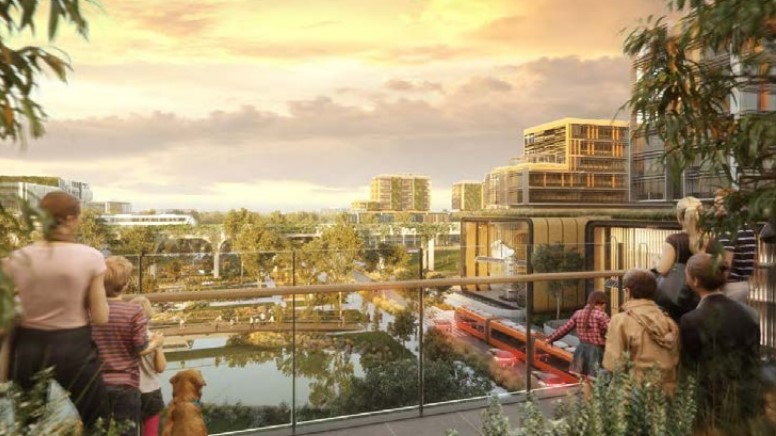Airport traffic levels have taken a battering during the COVID-19 pandemic, but government and industry figures are optimistic that CSIRO’s major commitment to Sydney’s ‘third CBD’ will turn the evolving Western Sydney Airport aerotropolis into a major innovation hub.
From 2023, the major research and innovation organisation will begin relocating up to 450 staff and researchers to the Aerotropolis Core precinct as it expands to fill the space around Badgerys Creek, where CSIRO will take residence in an 18,000 square metre premises as Sydney’s second airport opens in 2026.
CSIRO’s new facility, which will sit at the heart of the Aerotropolis Advanced Manufacturing & Research Precinct, will unify research institutes and commercial organisations around an array of collaborative workshops, meeting spaces, as well as updated facilities and laboratories.
It will “confirm the precinct as the future epicentre for science, research, innovation and industry collaboration in the Asia-Pacific,” NSW Minister for Jobs, Investment, Tourism and Western Sydney, Stuart Ayres, said in announcing the deal.
The facilities will span research areas including advanced manufacturing, quantum technologies, aerospace, defence, and agribusiness.
This includes the first CSIRO Urban Living Lab at the Sydney Science Park in Western Sydney; a $25m partnership with the NSW Government to generate new jobs and support STEM education in the region; and a ‘digital twin’ of the Western Sydney City Deal that will include a ‘virtual 4D model’ of Western Sydney.

An artist's impression of the Western Sydney Aerotropolis. Soure: NSW Government
CSIRO – which has moved to capitalise on great expectations around quantum technology and has also invested heavily in areas such as cybersecurity – will also take out a 10-year lease in the new $350m ‘Innovation Quarter’ precinct, putting its digital health and nutrition researchers at Westmead.
"The more we can put science in the hands of real people to solve real problems, the better our future will be,” CSIRO chief executive Dr Larry Marshall said, calling the “collaboration and connectedness of the Western Sydney Aerotropolis… an immense opportunity for CSIRO and the future we are shaping for Australia."
Planting the seed of innovation
The term ‘aerotropolis’ refers to the ecosystem of interconnected businesses that collocate around a major air hub, providing them with direct access to major domestic and overseas markets thanks to close ties to the airport.
The model has become increasingly popular as emerging and established businesses pursue new business opportunities accessible by air, and partnerships with like-minded collaborators that are also attracted to the innovation precincts.
Town planners at Narromine Shire Council, west of Dubbo, have pursued a similar strategy – albeit on a much smaller scale – in developing airport areas that recently secured the tenancy of flying-car innovator AMSL Aero.
Years in development, the Western Sydney Aerotropolis is ultimately expected to house 200,000 new jobs in Western Sydney, including rail links to a third major central business district that will span five precincts including Aerotropolis Core, Northern Gateway, Badgerys Creek.
With more than half of Sydney’s population expected to be living west of Parramatta within the next 40 years, Sydney city planners have been working to rebalance the region’s economic base as a ‘metropolis of three cities’.
“Having three cities, each with supporting metropolitan and strategic centres, will put workers closer to knowledge-intensive jobs, city-scale infrastructure and services, entertainment and cultural facilities,” the Greater Sydney Commission explains.
The airport itself – named the Western Sydney International (Nancy-Bird Walton) Airport will be built in stages, with the first stage including a single runway capable of handling up to 10m passengers per year.
Decades in planning, the airport was designed to meet demands for aviation services that are expected to double within 20 years.
Yet the COVID-19 pandemic has changed those expectations, with traffic data showing Sydney’s current Kingsford Smith Airport almost empty as air travel falls off a cliff and passenger volumes drop 93.6 per cent year-on-year.
The aerotropolis’s six-year timeframe may thus prove fortuitous as Australian air travel slowly recovers from the current slowdown.
Developers were excited by the CSIRO’s announcement, with Property Council of Australia Western Sydney regional director Ross Grove saying, “the presence of CSIRO in the Aerotropolis adds value to every other employment and investment attraction initiative in the region.”
“It marks the beginning of a genuine innovation cluster and a new centre supported by the infrastructure of the future.”










